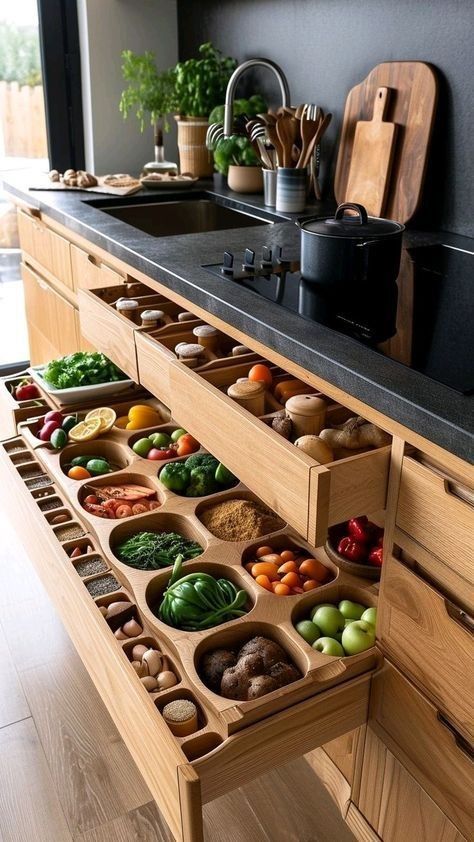Food storage is an essential part of maintaining a healthy kitchen and reducing food waste. In today’s fast-paced world, we often find ourselves with a fridge full of groceries, yet little time to prepare meals every day. This is where proper food storage techniques come into play, helping extend the shelf life of ingredients, preserving their freshness, and ensuring that we’re not throwing away perfectly good food simply because it wasn’t stored correctly.
Understanding how different types of food should be stored can save you both time and money. Fruits and vegetables, for example, require different conditions to stay fresh. Leafy greens, like spinach and lettuce, often wilt quickly if left in open air, but when wrapped in a damp paper towel and placed in an airtight container, they can stay crisp for days. On the other hand, vegetables like potatoes, onions, and garlic should never be stored in the fridge, as the cold temperatures can alter their texture and flavor. Instead, they thrive in a cool, dark pantry where airflow can help maintain their freshness for weeks.
One of the most common mistakes people make when it comes to food storage is overcrowding the refrigerator. While it may seem convenient to pack everything in, an overstuffed fridge can actually cause food to spoil faster. Air needs to circulate freely to maintain consistent temperatures throughout the fridge. Without proper circulation, some areas may be too warm or too cold, leading to uneven cooling and faster spoilage. To combat this, try organizing your fridge with clear zones. Keep dairy products in the coldest part, typically the back of the fridge, while fruits and vegetables should be stored in the designated crisper drawers, which help control humidity.
Freezing is another highly effective method of food storage that allows you to preserve items for months at a time. However, not all foods freeze equally well. For instance, high-water-content vegetables like cucumbers and lettuce don’t fare well in the freezer because they become mushy when thawed. On the other hand, meats, soups, and many cooked dishes freeze beautifully, retaining much of their original texture and flavor when stored in proper freezer-safe containers. Always ensure that the food you’re freezing is sealed tightly to prevent freezer burn, which can degrade the quality over time. Labeling your frozen items with dates is a good practice too, helping you keep track of how long something has been stored.
Dry goods such as grains, flour, and pasta also require thoughtful storage. Keeping them in their original packaging can invite pests and expose them to moisture, which can lead to spoilage. The best approach is to transfer these items into airtight containers, which not only protect them from pests but also help maintain their quality by keeping out moisture. Glass jars or BPA-free plastic containers are ideal for this purpose. For items like rice and flour, storing them in a cool, dark place such as a pantry or cupboard will help them stay fresh for longer.
In addition to storing foods correctly, it’s important to consider how to store leftovers in a way that ensures both food safety and quality. After a meal, many of us simply place leftovers in the fridge without much thought, but a few simple adjustments can make a big difference in how long those leftovers last. Make sure that food has cooled down to room temperature before placing it in the fridge, as putting hot food directly into the refrigerator can raise the overall temperature inside, compromising other stored items. Use shallow containers to store leftovers, as they cool down more quickly and evenly, reducing the risk of bacterial growth.
Labeling and organizing your food storage areas can also make a big difference in how efficiently you use your ingredients. By knowing what you have and when it needs to be used, you can cut down on the number of forgotten items that sit in the back of the fridge or pantry until they go bad. Try keeping a simple inventory, rotating older items to the front so they’re used first, and only buying what you need on your next grocery trip. This not only reduces food waste but helps you save money by making the most out of every purchase.
Vacuum-sealing is another advanced food storage technique that extends the life of food by removing air, which is a key factor in food spoilage. Without oxygen, bacteria and mold have a much harder time growing. Vacuum-sealing is particularly effective for meats and other perishables that you want to store for longer periods, especially if you don’t plan to use them immediately. Combined with freezing, vacuum-sealing can keep foods fresh for months or even longer without sacrificing flavor or texture.
One of the lesser-known aspects of food storage is understanding how different foods interact when stored together. Some fruits, like apples and bananas, produce ethylene gas as they ripen, which can cause nearby fruits and vegetables to spoil more quickly. Keeping ethylene-producing fruits separate from other produce can help extend the life of your fruits and veggies. Additionally, foods like bread should be kept in a bread box or sealed bag at room temperature, not in the fridge, where they can dry out and become stale more quickly.
Ultimately, successful food storage is about understanding the specific needs of each type of food and making small adjustments to your routine to ensure they’re stored in the right conditions. From the fridge to the pantry, freezer, and beyond, paying attention to how you store your food can result in fresher meals, less waste, and a more efficient kitchen. Whether it’s wrapping herbs in a damp cloth, transferring grains to airtight containers, or vacuum-sealing meats for longer storage, these small steps can make a big difference in keeping your food fresh and reducing waste. By mastering the art of food storage, you not only ensure that your ingredients are always at their best but also save time and money in the process.

